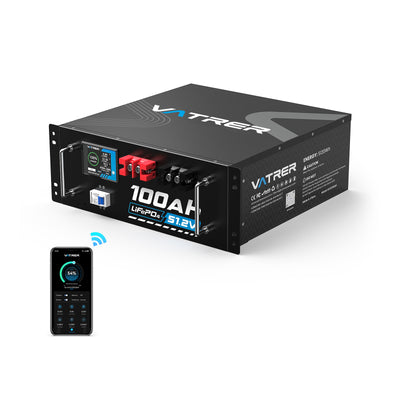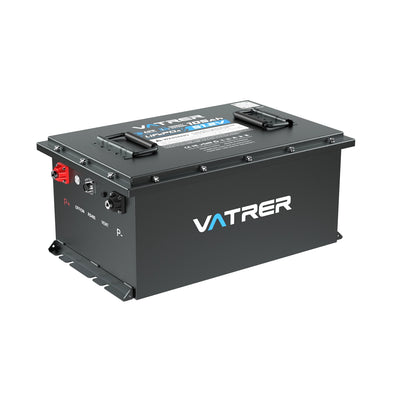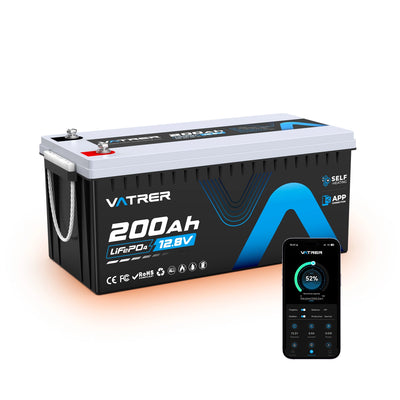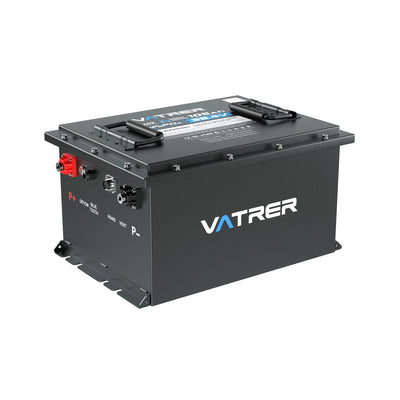RV Battery Winter Storage Comprehensive Guide
Reading time 6 minutes
As temperatures begin to fall, many motorhome owners prepare their vehicles for the winter season by emptying tanks, sealing windows, and protecting tyres. Yet one essential task is frequently overlooked: properly storing the RV battery.
Cold conditions do more than slow the vehicle itself—they significantly alter the internal chemical processes of the battery. Incorrect storage may result in frozen electrolyte, reduced performance, or even irreversible damage. A battery left unattended throughout winter may fail completely by spring, leading to costly replacements and unexpected downtime.
This guide explains how to store your RV batteries correctly, shield them from freezing weather, and maintain a healthy power system—whether you plan to park your motorhome for several months or continue travelling in colder regions.

How Cold Weather Affects RV Batteries
Different battery chemistries react to low temperatures in their own way. When the weather turns cold:
- Chemical activity slows, causing reduced voltage output and sluggish charging behaviour.
- Batteries continue to self-discharge even when unused, with cold accelerating the drop in voltage.
- Flooded lead-acid batteries may freeze if stored partially charged, often resulting in internal damage.
- LiFePO4 lithium batteries may stop accepting charge below 32°F due to built-in protection within the BMS (Battery Management System).
- Leaving a battery deeply discharged throughout winter can lead to permanent loss of capacity.
- The preferred storage environment is a dry, ventilated area kept between 40°F and 70°F.
Tips: If your motorhome remains outdoors, consider insulating the battery bay or moving the battery to an indoor location to prevent exposure to freezing temperatures.
Identify Your RV Battery Type Before Storage
Different battery types require different care routines. Understanding which one you have ensures proper maintenance and prevents unintended damage.
| Battery Type | Winter Risks | Best Storage Tips |
|---|---|---|
| Flooded Lead-Acid Batteries | Freezing, sulphation, water evaporation | Keep fully charged, check electrolyte level, top up with distilled water, store above freezing in a dry environment |
| AGM (Absorbed Glass Mat) | Gradual loss of capacity | Store fully charged, check voltage monthly, use a smart maintainer or trickle charger |
| Gel Cell | Sensitive to temperature and overcharging | Avoid heat exposure, monitor voltage, store where temperatures remain stable |
| LiFePO4 Lithium RV Battery | Cannot be charged below freezing | Store at 40–60% charge; use a heated enclosure or a self-heating lithium model |
Pro Tips: Modern self-heating lithium RV batteries, including Vatrer’s advanced LiFePO4 designs, warm themselves before charging so they can be used safely even in below-zero weather.
Key First Steps RV Battery Before Winterizing
Before storing your RV for the winter, complete these critical tasks to avoid damage and make your spring setup much easier.
a. Fully Charge or Partially Charge the Battery
Lead-acid batteries should be charged to 100% to prevent sulphation and minimise the risk of freezing.
For lithium RV batteries, store them at around 40–60% state of charge to reduce long-term cell stress.
b .Disconnect the Battery
Switch off the RV’s main disconnect and remove the negative cable before the positive.
This prevents parasitic loads—such as alarms, sensors, or onboard electronics—from draining the battery.
c. Label or Photograph Cables
Take a quick photo of the setup beforehand to ensure proper reconnection later.
d. Remove the Battery (If Possible)
In areas with severe winters, take the battery out of the vehicle entirely.
Store it indoors in a dry room with controlled temperature, such as a heated garage or basement.
Avoid placing it directly on concrete—use timber or an insulating pad to limit moisture contact.
e. Clean the Terminals
Use a wire brush to remove corrosion and apply a light coat of dielectric grease to prevent oxidation.
Lead-Acid Battery Storage Tips
Lead-acid batteries require the most care during winter:
- Make sure the battery is fully charged before being stored, as higher charge levels resist freezing and sulphation.
- Check electrolyte levels in flooded batteries and refill with distilled water to the correct marker if needed.
- Store the battery somewhere cool and dry, ideally above freezing.
- Use a smart charger or maintainer every 1–3 months to keep the battery healthy without overcharging it.
- Avoid enclosed spaces where hydrogen gas could accumulate.
Tips: If terminals show white or green deposits, clean them with a baking soda solution before applying grease again.
Lithium Battery Storage Tips
Lithium RV batteries—especially LiFePO4—are simpler to maintain but still require temperature awareness.
- Store between 40% and 60% charge instead of fully charged.
- Keep in a temperature-controlled location between 50–68°F; avoid long periods below 32°F.
- Since lithium batteries self-discharge slowly, check every few months and recharge if the voltage drops below roughly half capacity.
- If equipped with Bluetooth, use the monitoring app to check status remotely.
- For winter camping, use an insulated battery compartment or heating accessory.
Tips: Never charge a lithium battery below freezing unless it has an integrated heating function—doing so risks lithium plating and irreversible damage.
Should You Leave the Battery in the RV or Remove It?
Your decision depends largely on where and how your RV is stored:
| Condition | Recommended Action | Notes |
|---|---|---|
| Very cold climate, no shore power | Remove the battery | Store indoors to avoid freezing damage |
| Moderate climate, shore power available | Leave in RV | Use a smart charger or maintainer to avoid overcharging |
| Variable conditions | Follow manufacturer’s BMS guidance | Check voltage monthly; maintain above 12.4V (lead-acid) or 50% SOC (lithium) |
Tips: Even if the battery stays inside the RV, check it occasionally for voltage, corrosion, and cable condition.
Monitoring and Maintenance During RV Battery Storage
Routine checks during the winter months help ensure your battery remains reliable and ready for use. However, the maintenance required differs between lead-acid and lithium RV batteries.
| Battery Type | Charging During Storage | Voltage Check | Temperature Range | Special Care |
|---|---|---|---|---|
| Flooded / AGM Lead-Acid | Use a maintainer or recharge every 1–3 months | Every 4–6 weeks | Above 40°F | Check electrolyte and clean terminals |
| Lithium (LiFePO4) | No maintainer needed; recharge if voltage drops below 13.0V | Every 2–3 months | 40°F–70°F | Store at 40–60% charge; avoid freezing conditions |
Tips: For lead-acid batteries, remove corrosion with a baking soda mixture before rinsing and drying. For lithium batteries, avoid charging below 32°F unless the battery includes a heating feature, as this can permanently damage the cells.
RV Battery Troubleshooting After Winter
Before reinstalling the battery in spring, carry out these checks:
- Swollen casing or cracks: discard immediately—this indicates freezing or overcharging.
- Corroded terminals: clean with baking soda solution, rinse, and dry.
- Rapid voltage drop after charging: may signal sulphation or aged cells.
- Unusual odour (rotten eggs): could indicate an acid leak—replace the battery without delay.
- Weak engine start: low cold-cranking performance—test before travelling.
Recommended Tools for Winter RV Battery Care
| Tool / Product | Purpose | Example Brands |
|---|---|---|
| Smart Battery Maintainer | Maintains voltage stability without risk of overcharging | NOCO Genius, Victron Blue Smart |
| Battery Monitor | Measures voltage, SOC, and temperature | Victron BMV |
| Insulated Battery Box | Prevents freezing and protects from moisture | Camco |
| Heating Pad or Blanket | Keeps lithium batteries within safe operating temperature | Kat’s, Facon |
| Dielectric Grease | Prevents corrosion on terminals | CRC, Permatex |
Why Proper Storage Saves Money and Extends RV Battery Life
A well-maintained battery may last twice as long as one left unattended. Preventing freeze damage, corrosion, and deep discharge can save significant replacement costs.
By keeping the battery at a stable temperature and maintaining appropriate charge levels, you protect both your electrical system and your long-term investment in your motorhome.
Conclusion
Maintaining your RV battery throughout winter is one of the most effective ways to preserve system performance. Whether you rely on traditional lead-acid batteries or modern lithium RV battery technology, the essentials remain the same: keep them charged, protected, and away from freezing conditions.
Vatrer Battery provides advanced lithium RV batteries engineered for long-term dependability, featuring intelligent BMS protection, low-temperature charging safeguards, and optional self-heating technology. These capabilities simplify winter storage and ensure your battery is ready whenever you return to the road.
Share



















































